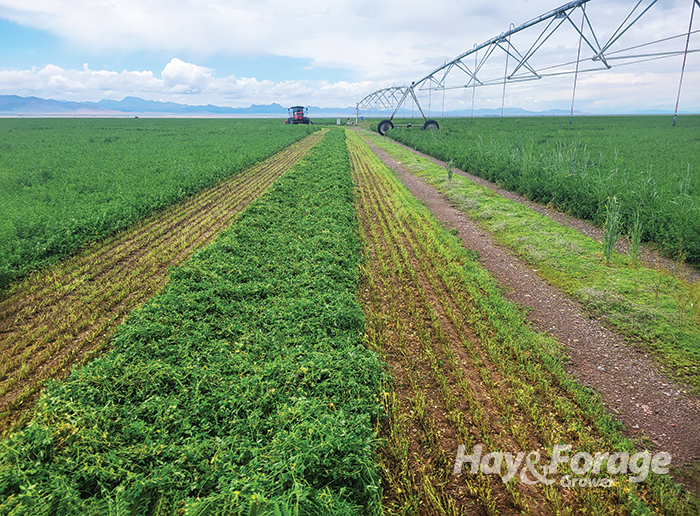
Robert Holt established the operation that was originally rooted in potato production in 1971, rotating alfalfa between spud harvests. Then, the potato market contracted, and alfalfa became the number one crop. Over time, farm management also shifted to the second and third generations of Holts, including Robert’s oldest son, Randall, and Randall’s oldest son, Tanner.
As a child, Tanner remembers when baling and selling hay was one of the primary farm enterprises — but things continued to change. He left their hay farm as a young adult to serve as a missionary, but he returned to a dairy.
“Growing up, I’d always ask my dad why we didn’t dairy, and he’d say that was the worst idea ever,” Tanner laughed. “When I was away on my mission and got the email that my dad and uncle were looking to start a dairy, I replied, ‘Dad, that is the worst idea ever.’”
At this point, the Holts were also growing corn for silage and triticale in addition to alfalfa to feed their Holstein-cross herd. But as alfalfa became a culprit for high water consumption in the increasingly water-deficient West, the Holts started to reconsider their crop rotation and their perspective on irrigation.
Now, instead of trying to maximize production per acre, their current philosophy is to capture the most crop per drop. In other words, they measure how much protein and fiber value they produce per inch of irrigation, instead of prioritizing the highest yields per acre-foot of water.
By working with the state of Utah since 2018, they’ve created the framework for a system that provides more flexibility in groundwater usage from their aquifer by implementing rules that are similar to surface water irrigation. This is where the “crop per drop” piece comes in.
The idea is that if farmers can use less groundwater than their annual allocation by growing forages that yield more per inch of irrigation — rather than measuring production by the acre-foot — they should be able to roll their water savings over a five-year period.
“If we can account for aquifers the way we account for rivers, then more water may be used more efficiently,” Randall said. “If you have a low snowpack year, you may still have water from prior years. In a high snowpack year, you don’t get to pump more — it just means there is a little more recharge. Similarly, ‘use it or lose it’ for groundwater doesn’t incentivize efficient cropping.
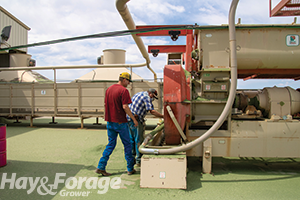
“We need to treat a limited resource like a limited resource,” he continued. “In the West, where we are short on water, we ought to incentivize saving water so you can get the most out of each drop, not the most out of each acre.”
During the trial period of their water savings system, they were required to give up some of their total allocation. They received 40 inches of water per acre instead of the 4 acre-feet that their water district has historically granted them. Therefore, the Holts redesigned their pivots to be more efficient.
Irrigation renovations
In 2020, they retrofitted pivots to meet low-energy precision application (LEPA) standards by using regulators to reduce water pressure and lowering hoses and nozzles closer to the ground. Doing so was rather tedious, especially since the project took place when supply chains hit pause during the COVID-19 pandemic. At one point, the Holts owned or had ordered every available 3/4-inch T-cross fitting in the country.
“If you went to go buy a 3/4-inch T-cross in 2020, you would not be able to find it in the United States,” Randall chuckled. “Luckily, not many people needed them.”
They made time to reconstruct pivots in between crop harvests, aiming to update two or three systems after each cutting. Within two years, almost every pivot had been updated.
“It’s a lot harder to deal with,” Tanner said about LEPA irrigation. “There are three times as many hoses, three times as many nozzles, and smaller nozzles that plug more. When there is a mistake, it’s more expensive, but if you’re rewarded for doing it, then it’s worth the effort.”
On average, the Holts can get more than 5 tons of triticale per acre using about 10 inches of irrigation, whereas their alfalfa yields about 8 tons per acre across four cuttings with 48 inches of irrigation.
With one crop of triticale producing more than half as much of their total alfalfa yield using a fraction of the water, the Holts are optimistic about their approach to water conservation. They’ve expanded to growing about 7,000 acres of triticale and harvest crops during boot stage to capture high protein and fiber digestibility. In fact, their triticale averages more than 14% crude protein (CP) and 60% total digestible nutrients (TDN).
“When you measure value by the acre, alfalfa gives you the most value per acre, and triticale doesn’t do as well,” Randall said. “But when we measure protein by the inch of water, triticale is really promising.” Hybrid rye is another species that the Holts have dedicated more acreage to because of its water savings potential.
“This whole water thing is changing how we look at drops per yield and it’s encouraging us to try different things,” Tanner said.
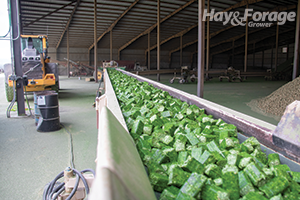
Chopping and cubing
Even with a focus on alternative forages, alfalfa isn’t totally out of the picture. It still comprises roughly 4,500 acres of the farm and is all dry chopped. The family has always dry chopped alfalfa, Tanner said, which he contends is more efficient than making dry hay.
For dry chopping, alfalfa must still dry down to about 8% moisture, but the Holts don’t have to wait for dew to set in and rehydrate the forage like they would if they were baling hay. This saves them days of harvest time, and they don’t have to harvest in the middle of the night — or into the wee hours of the morning.
The Holts note that dry chopping alfalfa creates a more uniform product since all forage gets mixed together. “In a bale, you get exactly what was in that part of the field right where you baled it,” Randall said.
The dry-chopped alfalfa is then made into cubes for the export market. Alfalfa cubes are denser and easier to transport, and more sought after by some countries that have higher standards for hay appearance.
“We have a marketing advantage because of how green everything is. It may not be more nutritious, but visually, it’s more appealing,” Randall said.
Cubing dry-chopped alfalfa also allows for a second chance at forage quality control. For example, the hay cuber can sense alfalfa that is too wet for compression and redirects it from the rest of the product. “When you see that in a bale, you can’t untie the bale to get the bad stuff and then put the bale back together,” Randall added.
This doesn’t come without its challenges, though. Exporting forage involves a whole list of liabilities that don’t necessarily exist in the domestic market. In addition to higher expectations for green alfalfa, the Holts must uphold strict standards for cleanliness. If any foreign object, random part, or even an insect is present with the cubes in a container, the entire shipment could be rejected.
Moreover, compressed bales have gained more demand than alfalfa cubes over the years, but sticking with the practice has been to the Holts’ advantage. With fewer players in the cubing game, they have acquired more market share.
“It’s gotten to be a very narrow market, but we make some of the best,” Randall said proudly. Any excess or low-quality cubes are fed on the dairy, but the Holts primarily chop alfalfa, triticale, and corn silage for their cows.
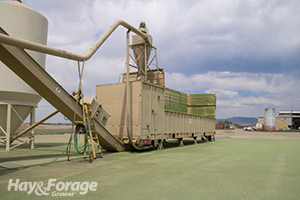
Farming for the future
Compared to other farmers, the Holts may think outside the box, but they share in the struggles that all forage producers encounter. Between last frost dates that creep into June and first frost dates that come as soon as September, managing the weather on top of irrigation tends to be the biggest hurdle. In their part of the Beehive State, the Holts receive roughly 10 inches of annual precipitation from rain and snow. The bulk of that moisture arrives in mid-summer on the heels of Arizona’s monsoon.
Despite variable weather and uncertain water availability, the Holts believe their shift in irrigation management is a bright spot for their operation. Not only does it enhance the productivity and environmental sustainability of their forage system, but it has proved to be a profitable endeavor from a farm business standpoint, too.
“Our motivation for poking our heads above the radar on these water issues is to draw attention to the fact that we are going to be farming with less water in the future. We are going to have to figure out how to raise forage more efficiently,” Randall said.
“If we can improve our water efficiency, it will help us — and help our kids — be able to do what we do,” Tanner added.
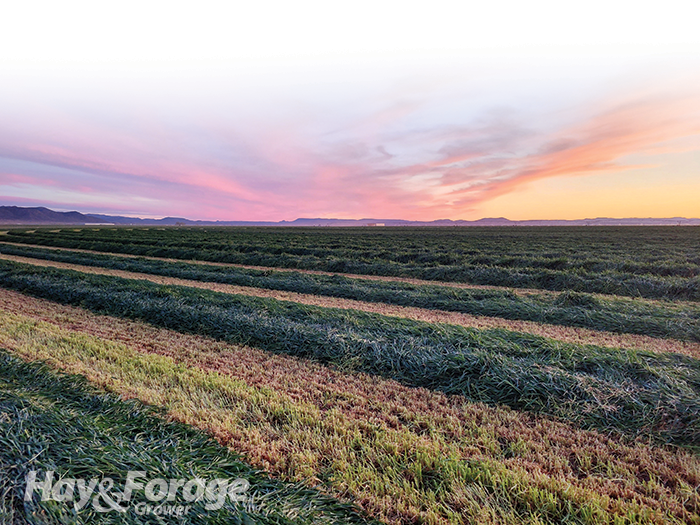
This article appeared in the July 2025 issue of Hay & Forage Grower on page 6-8.
Not a subscriber? Click to get the print magazine.

